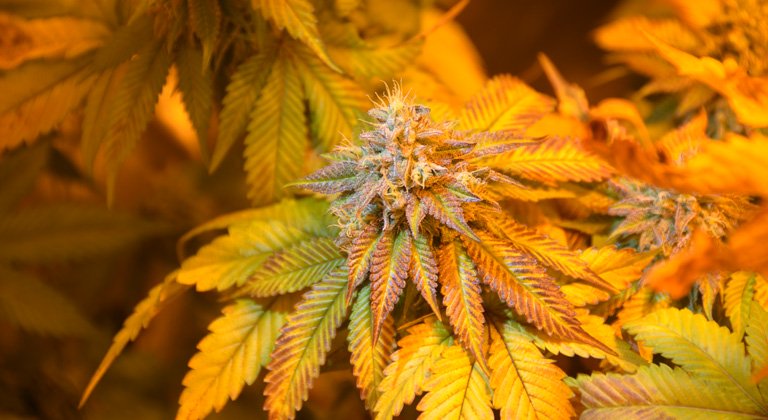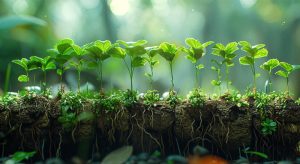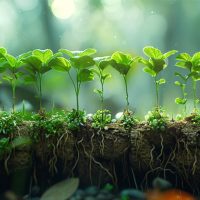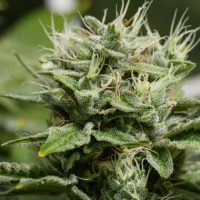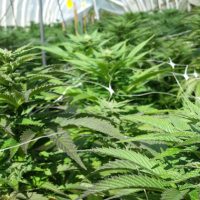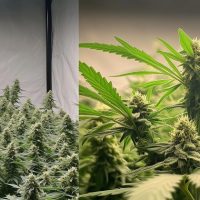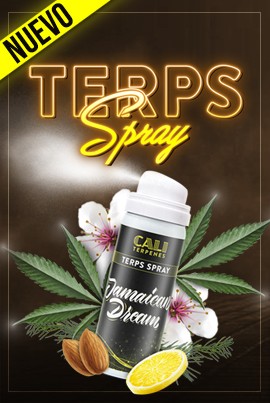There are several reasons why the leaves of cannabis plants can turn yellow; it’s important to know what is causing this symptom as the problem may be more or less severe, or simply a natural function of the plant’s life cycle towards the end of its life.
In this article, we detail the causes for the appearance of yellow leaves in cannabis plants when they shouldn’t, as well as solutions to remedy this problem depending on its origin.
Primary Causes for Yellowing Cannabis Leaves
As we just mentioned, there are different reasons why cannabis leaves can turn yellow. Quickly identifying the root of the problem is essential to take the appropriate measures and reverse the situation.
Deficiencies in Cannabis Feeding
The health of your cannabis plant depends largely on a proper balance of nutrients. Among them, nitrogen plays a crucial role, being essential for cannabis plants during the growth period.
Nitrogen: How to Detect Deficiencies
Nitrogen is an essential component of chlorophyll, the substance that gives leaves their green color and enables photosynthesis. It’s also a vital component of amino acids, which are the building blocks of proteins necessary for the growth of all parts of the plant.
The first sign that your plant lacks nitrogen (N) is usually the loss of green color in the older and larger leaves, located at the bottom of the plant. This loss in green color gives way to an increasingly intense yellow, and if not remedied quickly this deficiency can progress, gradually affecting the rest of the leaves.
Stunted growth (excessively small plants) can also indicate a lack of nitrogen in the nutrition of your plants.
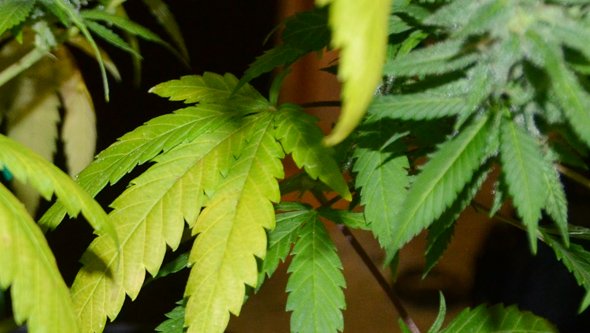
Solutions for Nitrogen Deficiency in Cannabis Plants
If you’ve determined that the yellowing of your plant’s leaves is due to a lack of nitrogen, you’ll need to adjust feeding using nitrogen-rich fertilizers suitable for the plant’s growth stage. If you follow the manufacturer’s instructions, you shouldn’t have problems. If, however, your plant continues to show symptoms of nitrogen deficiency, check for other possible causes.
If the nitrogen deficiency is due to inadequate fertilization, depending on the intensity of the yellowing of your cannabis plant’s leaves, it’s better to use a certain type of fertilizer.
Organic Fertilizers to Address Mild Nitrogen Deficiency
Organic fertilizers such as bat guano or liquid fertilizers based on fish emulsion or seaweed are ideal for slow and sustained nutrient release. These fertilizers improve soil structure and enhance its ability to retain water and nutrients. Additionally, they are especially effective for the long-term care of your plants, ensuring they receive a balanced diet.
Mineral Fertilizers to Reverse Moderate or Severe Nitrogen Deficiency
Non-organic fertilizers, also called mineral fertilizers specifically formulated for cannabis plants, act more quickly than organic ones and are the best choice for quickly correcting severe nutritional deficiencies.
These fertilizers come in various formulations that can target specific plant needs. However, you must handle them with care, as they can be a double-edged sword. Due to their concentration and rapid release, issues with dosage (adding more than necessary) can be costly.
In just one day, you could end up with your plants “burned” by over-fertilization, manifested as dry leaves and leaf tips. It’s important to pay attention to the dosage. Besides considering the nutritional needs of the specific strain, not all strains are equally voracious.
Once the necessary corrections have been made in your plants’ diet (whether with organic or chemical fertilizers), they will need time to react to the change. It’s important to stay calm and be patient, observe your plants daily, monitoring whether the yellow color is increasing or decreasing.
If it’s not worsening, continue with the new feeding regimen until the color turns green again. Keep in mind that heavily affected leaves may never recover, but the rest should regain a healthy color.
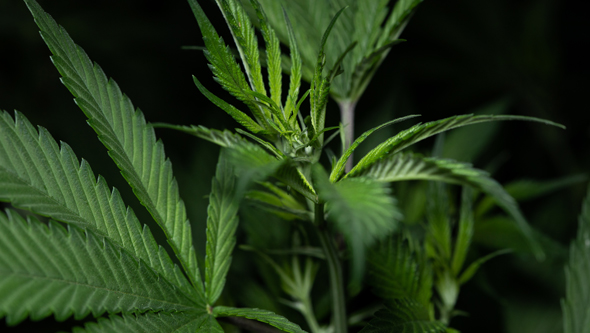
Other Nutritional Deficiencies that can Cause Yellow Leaves in Cannabis Plants
While nitrogen deficiency is the most common cause, there are other nutritional deficiencies that can lead to yellowing of your cannabis plant’s leaves. Here is a summary of symptoms and solutions.
Yellowing Cannabis Leaves due to Potassium Deficiency
This macronutrient is essential for water regulation and photosynthesis in cannabis plants.
- Symptoms of potassium deficiency in cannabis: tips and edges of leaves yellowing or burning. It usually appears during the flowering stage of plants, as the formation of buds requires a significant amount of potassium.
- Solution: Apply a fertilizer with a higher potassium content.
Magnesium Deficiency in Cannabis Plants and Yellow Leaves
Magnesium is a fundamental element in cannabis feeding, as it contributes to chlorophyll synthesis.
- Symptoms of magnesium deficiency in cannabis: yellowing between the veins of the older leaves. It often occurs due to exposure to excessively low temperatures that hinder magnesium absorption.
- Solution: use magnesium supplements such as Epsom salts or Canna Magnesium. You can also raise the temperature in your room if it’s too low.
Appearance of Yellow Leaves due to Iron Deficiency in Cannabis
Iron is classified as a micronutrient, but it plays a crucial role in cannabis development, as it’s necessary for chlorophyll production. A lack of iron can be one of the reasons cannabis leaves turn yellow.
- Symptoms: you’ll recognize it as an iron deficiency because yellowing occurs in growing leaves, the younger ones, and new shoots, while the veins remain green.
- Solution: use iron-rich fertilizers or adjust the pH to enhance its absorption.
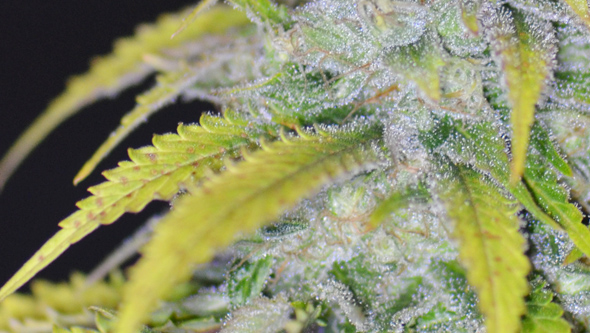
Watering Issues that can Cause the Appearance of Yellow Leaves in Cannabis
Proper watering is crucial for the well-being of cannabis plants. Both overwatering and underwatering can cause stress in plants, often manifested by yellowing leaves.
Yellowing Cannabis Leaves due to Overwatering
Each plant requires a different watering schedule, and cannabis plants, in particular, prefer a “wet-dry” cycle rather than consistently moist soil.
Excess watering is one of the most common mistakes in cannabis growing and one of the causes of yellowing leaves. How will you know if you’ve overhydrated your plants?
- Symptoms: when leaves turn yellow and become limp, weak, and fall (even without being yellow), and plant growth slows down, there may be overwatering. Along with these symptoms, check if you have kept the substrate of your plants constantly moist.
- Solution: reduce the watering frequency and ensure that the soil is dry to the touch a few centimeters deep, before watering again. Experienced growers often lift the pot to gauge its weight; a lighter pot indicates dry substrate, while a heavier one means it still contains water. This skill is acquired through practice. The idea is for the substrate to dry considerably between waterings (not completely), stimulating root growth and keeping the plant hydrated. Continuous excess water, oddly enough, can lead to uneven water distribution in the plant, creating nutrient problems quickly. Improving soil or pot drainage will also help prevent water pooling at the bottom and excess humidity.
Yellow leaves in cannabis plants due to Underwatering
Underwatering in your cannabis grow (frequent watering or insufficient amounts) will also negatively affect your plants. Cannabis needs water to support its metabolic and growth functions; when the appropriate amount is not provided, among other symptoms, the plant’s leaves can turn yellow.
- Symptoms: wilted or dry leaves and stunted growth may indicate a lack of water. Additionally, severe water scarcity is easily noticeable, as depending on conditions and cultivation type, the plant’s leaves may suddenly appear very “droopy.” This can be confused with a Fusarium fungus infection, which produces a similar effect. However, the difference is that an excessive lack of watering will make the leaves throughout the plant generally droop, while Fusarium, in its initial stage, will affect only some parts of the plant.
- Solution: if you are using enough water, increase the frequency of watering. If the frequency is correct, increase the amount of water given.
So… How much and when should I water my cannabis plants to avoid problems?
If you want to avoid mistakes when watering your cannabis plants, follow these simple rules:
- Water slowly, allowing the water to be absorbed slowly without overflowing or draining quickly.
- When watering, the substrate should end up completely wet.
- Weigh the pot when it’s watered and make a mental note of it for the future.
- Water again when the surface is dry. – to check this, stick your finger in and check that at least the top third of the substrate is dry.
- Weigh the pot before watering it again. Do you notice how little it weighs now?
- You should keep in mind that the water must be at an appropriate temperature: if it’s too cold or hot, it could affect your plant’s health. A temperature between 20 to 24 degrees is perfect.
- Make sure that pH values and overall water quality are suitable.
- Carefully observe your plants to adjust watering as needed.
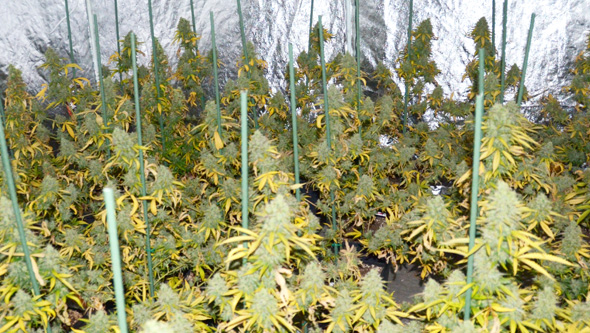
Issues with pH in Water that can Cause Cannabis Leaves to Turn Yellow
The pH, or acidity/alkalinity level of the soil or nutrient solution in which your cannabis plant grows is a crucial factor that influences its overall health. Inappropriate pH can lead to various problems, including yellowing of the leaves.
Importance of Proper pH in Cannabis Plants
A balanced pH level is essential for the proper absorption of nutrients. pH levels that are too high or too low can block the availability of essential nutrients, leading to nutritional deficiencies, even if these nutrients are present in the soil or nutrient solution.
What is the Optimal pH Range in Cannabis Plants?
For most cannabis plants, the ideal soil pH range is between 6.5 and 7.0, while in hydroponic systems, it should be between 5.5 and 6.5.
Identification of pH problems in Cannabis Plants
- Symptoms of inappropriate pH: yellowing of the leaves can be an indicator, especially if accompanied by other symptoms such as spots, stunted growth, or leaf drop.
- Diagnosis: to confirm that pH is causing leaf yellowing, pH tests of the soil or nutrient solution should be conducted. Check the pH value with a meter; there are digital ones and others that use reactive strips.
Solutions for pH problems in cannabis plants
- Adjusting soil pH: if the substrate pH is outside the ideal range, soil amendments can be used to adjust it. The use of calcium or diatomaceous earth can raise low pH, while sulfur can help lower high pH.
- Adjusting pH in pots: pH in plants growing in pots is easier to regulate. Simply adjust the pH of the water and mixture just before watering. By consistently doing this, you ensure that pH levels are stable and correct.
- Adjusting pH in hydroponic cannabis grow systems: use specific pH-regulating solutions for hydroponics to increase or decrease pH as needed. In hydroponic systems, it’s essential to have absolute and rigorous control of pH levels, as a failure in this regard can be costly. While these systems are useful for accelerating plant metabolic processes and achieving robust development and production, errors and deficiencies occur at a faster rate. Therefore, a pH error in hydroponics can be more challenging to balance and cause more significant damage than in soil grows.
- Water: ensure that the water used to feed your cannabis plants also has the correct pH. Tap water must be adjusted before use. Make sure the water in your area is not too “hard” (excessively calcareous), as it could damage your plants. For hydroponic systems, it’s better to use distilled water, to which fertilizers are added, and once done, it will be measured and adjusted to the correct pH. Many growers use osmosis filters to solve this problem.
How to maintain regular pH in Cannabis Plants
Maintaining adequate pH levels in your grow is pretty straightforward:
- Constant monitoring: in substrate systems (pots, soil), get into the habit of always measuring pH before watering. In hydroponic systems, it’s ideal to check pH daily.
- Maintenance of control devices: the proper maintenance of measurement devices is just as important as a correct pH level. Remember that they are delicate tools, handle them with care, and calibrate them frequently. A poorly calibrated pH meter can lead to incorrect conclusions and decisions that can end the life of your plants.
Yellow leaves in Cannabis at the end of flowering
While it’s ideal for cannabis plants to appear green and healthy throughout the growth and flowering stages, during the ripening stage (usually the last 7-10 days), plants should start adopting more yellowish hues.
Why do cannabis plants have to end up yellow? Well, for the flowers of the plant to have the best possible flavor and be as healthy as possible, the plant must have metabolized the nutrients provided both in the soil and in the plant itself.
How do you achieve this? Easy.
During the last 7-10 days (even 15 depending on the plant’s condition), there are several options to reduce the nutrient level still present in the plant and allow it to metabolize them.
It’s essential to consider that the plant uses the nutrients in the soil as long as possible. When the plant does not find nutrients in the soil, it takes them from the leaves. This is why leaves begin to yellow with root flushes or when fertilizers are stopped.
- (Option 1) Start reducing fertilizers 15 days before harvest and stop using fertilizers around day 7 before harvest.
- (Option 2) Completely stop using fertilizers and additives about 7-10 days before harvest and observe the plant’s tone. If it’s dark green, it likely needs a root flush with water and/or a product that facilitates this process, such as Canna Flush or Flawless Finish.
- (Option 3) Perform a root flush directly 7-10 days before harvest to remove excess nutrients from the soil, allowing the plant to metabolize the nutrients contained in the leaves.
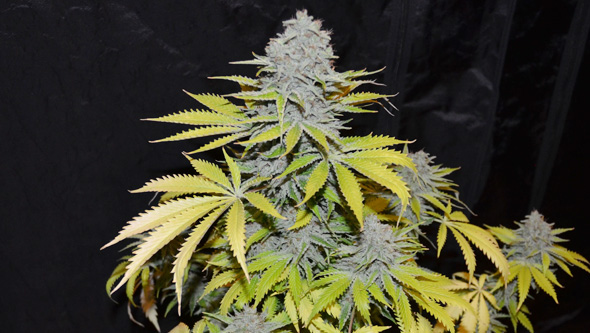
Final Conclusions
To keep your plants green, healthy, and prevent their leaves from turning yellow, try to adhere to the following recommendations:
- Use a quality substrate specifically designed for growing cannabis plants.
- Fertilize with high-quality fertilizers and adhere to the doses indicated by the manufacturer.
- Observe the color and growth of your plants; they should display a natural green color, and their growth should be continuous.
- Monitor the temperature of your grow room/tent, as well as the water temperature.
- When in doubt, consult a professional; it’s better to be safe than risk ruining your harvest.
As we have seen, there are many reasons why cannabis leaves may turn yellow. The most important thing is to identify the root of the problem and act quickly. We hope that with the tips we provide, your plants will enjoy excellent health, and yellow leaves won’t make an appearance. Happy harvesting!
